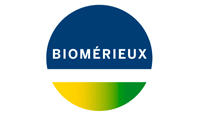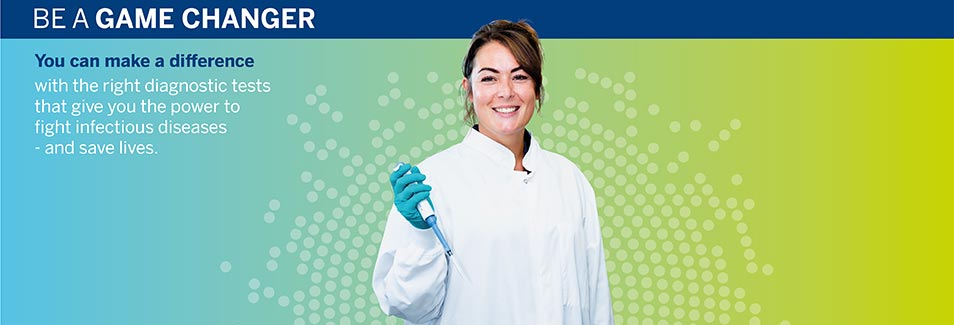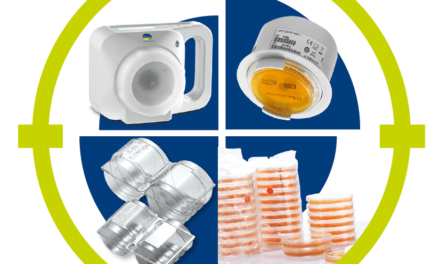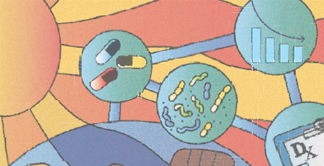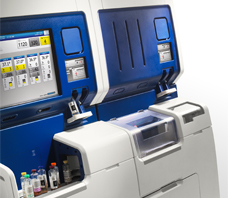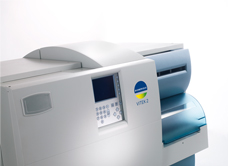![]()
Spectra Biologie met with Prof. Emmanuelle CAMBAU, Clinical Biologist and Head of the Bacteriology Laboratory at the Lariboisière hospital in Paris and Dr. Gauthier PEAN DE PONFILLY, Clinical Biologist and Assistant Specialist. They shared their experience of the MYLA® – BACT/ALERT® VIRTUO® solution.
Spectra Biologie: Pr. CAMBAU, could you please introduce us to your hospital group and laboratory?
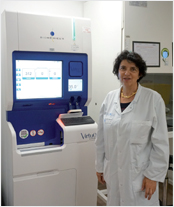 Emmanuelle CAMBAU: We are part of one of the public health hospital groups of Paris called the Lariboisière-Fernand Widel University Hospitals, which have about 1,500 beds altogether. Our Biology Centre is split between two hospital sites, St. Louis and Lariboisière. The Lariboisière-Fernand Widel Hospital’s beds include about 700 acute care beds and 200 beds for rehabilitation follow-up, geriatrics and psychiatry. Lariboisière is one of Paris’ largest centres for emergency medicine and surgery, treating about 100,000 emergency cases per year. There is quite a high rate of bacterial infection since globally there are about 800 daily doses of antibiotics for 1,000 days of hospitalization. These numbers reveal the high stakes involved when it comes to diagnosis of bacterial infections in our hospital. That’s the Bacteriology Laboratory’s primary mission. We therefore launched a comprehensive evaluation on the diagnosis of bacteremia and fungemia. Dr. PEAN DE PONTFILLY, Assistant Specialist, is particularly involved, having been dedicated to this project for a year now. The Bacteriology Laboratory is currently undergoing accreditation.
Emmanuelle CAMBAU: We are part of one of the public health hospital groups of Paris called the Lariboisière-Fernand Widel University Hospitals, which have about 1,500 beds altogether. Our Biology Centre is split between two hospital sites, St. Louis and Lariboisière. The Lariboisière-Fernand Widel Hospital’s beds include about 700 acute care beds and 200 beds for rehabilitation follow-up, geriatrics and psychiatry. Lariboisière is one of Paris’ largest centres for emergency medicine and surgery, treating about 100,000 emergency cases per year. There is quite a high rate of bacterial infection since globally there are about 800 daily doses of antibiotics for 1,000 days of hospitalization. These numbers reveal the high stakes involved when it comes to diagnosis of bacterial infections in our hospital. That’s the Bacteriology Laboratory’s primary mission. We therefore launched a comprehensive evaluation on the diagnosis of bacteremia and fungemia. Dr. PEAN DE PONTFILLY, Assistant Specialist, is particularly involved, having been dedicated to this project for a year now. The Bacteriology Laboratory is currently undergoing accreditation.
Spectra Biologie: From your perspective, what are the key challenges when it comes to bacteriological tests, in particular those concerning blood cultures?
Emmanuelle CAMBAU: Since the Bacteriology Lab is not in the same building as the central reception and the pneumatic network, it is above all essential to be well organized relative to the hospital’s clinical services. I think that we underestimated this problem over the last fifty years by isolating the laboratories from prescribing clinicians. It is critical to overcome this problem in collaboration with our various colleagues – clinicians, biologists and the hospital leadership. We need to uphold a purely medical objective to improve care procedures for urgent bacterial infections. It behooves our organization to be clear and coherent with the expected diagnosis. We are dealing with serious infections, patients with a mortality risk of 5 to 50% in the case of septic shock. It is not possible to wait three days for the diagnosis of an infection when it has been well-shown that the longer the wait for appropriate antibiotic treatment to be implemented, the greater the risk of mortality.
We could imagine an ideal situation, which would be to place automated machines right within the clinical sites. However, working with bacteriology machines is not the job of caregivers in the clinical setting. On top of that, this would also pose a biological security risk to the clinical services team. We therefore need to bring the clinical services and the laboratories closer together. We are taking steps towards improvements, in partnership with our suppliers, to bring in instruments that are easy to load, and that control blood volume. We are going in the right direction.
Spectra Biologie: You previously used BACT/ALERT® 3D and have now evolved to the use of two BACT/ALERT® VIRTUO® machines driven by MYLA® software. What motivated your choice?
Emmanuelle CAMBAU: The main reason for our choice was to be able to make an automated blood culture system available to be loaded immediately during the night. We needed a system that was not dependent on a specialized technical team to load and unload the bottles, as was the case with the BACT/ALERT® 3D. With the BACT/ALERT® VIRTUO®, this task can be done by the staff at the main sample receiving area for the biology unit, which is near the pneumatic terminals. At night, these employees – who are not specialized in bacteriology – can perform the loading of blood culture bottles on a BACT/ALERT® VIRTUO® module A that we installed at this shared 24-hour sample reception area.
A second reason motivated our choice: the new feature for automated blood volume measurement, which is the basis of our plan to improve diagnostic quality. We started using the BACT/ALERT® VIRTUO® machines at the beginning of 2017.
Gauthier PEAN DE PONFILLY: The MYLA® solution enables us to oversee operations remotely and ensure that tasks are properly performed on the BACT/ALERT® VIRTUO®, even though it is situated outside of our lab.
Spectra Biologie: How did the installation go?
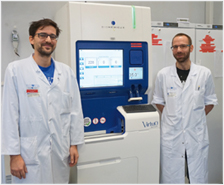 Gauthier PEAN DE PONFILLY: The two BACT/ALERT® VIRTUO® modules were connected to the MYLA® system, which is physically located at the Saint Louis hospital site. But the MYLA® software is connected to the main LIS that serves the entire biology unit, which enables us to access it. The bioMérieux applications engineers came onsite to train our personnel. The training was done over two days, with a general presentation, hands-on teaching on the machines and training on the MYLA® software. In complement to this, we configured our laboratory information system (LIS) with the help of bioMérieux and MIPS to be able to have results transferred from MYLA® and BACT/ALERT® VIRTUO® to the GLIMS LIS.
Gauthier PEAN DE PONFILLY: The two BACT/ALERT® VIRTUO® modules were connected to the MYLA® system, which is physically located at the Saint Louis hospital site. But the MYLA® software is connected to the main LIS that serves the entire biology unit, which enables us to access it. The bioMérieux applications engineers came onsite to train our personnel. The training was done over two days, with a general presentation, hands-on teaching on the machines and training on the MYLA® software. In complement to this, we configured our laboratory information system (LIS) with the help of bioMérieux and MIPS to be able to have results transferred from MYLA® and BACT/ALERT® VIRTUO® to the GLIMS LIS.
Spectra Biologie: What is your activity in terms of blood cultures and what changes were done following the implementation of the two BACT/ALERT® VIRTUO machines and the MYLA® software?
Gauthier PEAN DE PONFILLY: We receive about 16,000 blood cultures (each comprising one FA+ aerobic bottle and one FN+ anaerobic bottle) annually – or about 45 pairs per day on average. Before the BACT/ALERT® VIRTUO® installation, the bottles were only loaded during the bacteriology laboratory’s opening hours, from 7:30 a.m. to 6:30 p.m. This was a problem because with half the blood cultures being collected during the night, we calculated an average delay of 13 hours before starting incubation. With the MYLA® software, we know the time of collection that we recorded as well as the exact time that each bottle is loaded into the machine. This allows us to measure the time elapsed before starting incubation in real time.
Spectra Biologie: What is the advantage, for you, of having such an indicator with MYLA® software?
Emmanuelle CAMBAU: It is because of this MYLA® indicator that we were able to justify the purchase the BACT/ALERT® VIRTUO® and its use during the night. Identifying the particularly long delay before the start of incubation (13 hours) – a time parameter rarely measured in laboratories –was what convinced several colleagues to support us in obtaining the necessary budget and the reorganization of the night team’s work.
Gauthier PEAN DE PONFILLY: Our current objective is to evaluate the experience after one year to see the difference before and after implementing this new workflow. We already know that we have reduced the average time to the start of incubation to somewhere around two-and-a-half hours – the recommendations are that incubation begin within two hours following collection.
Spectra Biologie: What are the advantages of the joint MYLA®-BACT/ALERT® VIRTUO® solution?
Gauthier PEAN DE PONFILLY: With MYLA® we can easily check the number of blood cultures collected per patient or the number collected from each clinical department. We should soon be able to estimate the volume of blood collected per infectious episode per patient. Studies that enable evaluation of this volume are difficult to do. To feed our quality indicators, we only measured volumes once a year; we realized that this was unpredictable. MYLA® will enable us to optimize and standardize the measurement of this “sensitive” parameter in real-time. These supporting numbers will help us to educate the clinical departments.
The importance of respecting blood collection volumes – ideally 40 mL – is self-evident for laboratory professionals, yet this is far from being the case for those in the care services. Using the joint MYLA®-BACT/ALERT® VIRTUO® solution directly impacts our relationship with the clinical departments and on our diagnosis. MYLA® also tells us very rapidly if there are any deviations such as a greater delay in loading or unloading. This enables us to more rapidly take the necessary corrective measures.
The statistics that MYLA® provides offer precious information. We can extract a view of all the blood cultures collected in a given period with their positive or negative status. This lets us can calculate a percentage of positivity over the number of blood cultures or over the number of aerobic or anaerobic bottles. We can also get the average time to positivity. In order to supervise the proper usage of the automated machines — notably the BACT/ALERT® VIRTUO® that is in the common samples reception area — we set the MYLA® to perform a statistical follow-up of the delay in unloading. This is currently holding at between 15 and 30 minutes, which is perfectly acceptable. Since the installation of the BACT/ALERT® VIRTUO®, moreover, the staff and technicians working in the shared sample reception area feel like they are contributing more and are interested in having new tasks to perform.
Spectra Biologie: What quality indicators do you use on the MYLA®?
Gauthier PEAN DE PONFILLY: First off, there is an annual indicator: the rate of positivity which should be between 10 and 15%. Previously, we had to get this based on the data in our LIS, which was not easy. Today, we can access it in real-time on the MYLA® – in two clicks – per bottle and per blood culture (1 sample with 2 bottles).
Emmanuelle CAMBAU: With this indicator, we know if we are staying at a level that’s sufficiently high. Our objective is to raise it even higher by keeping track of volume, which is for us the second most important indicator.
Spectra Biologie: What other indicators would you like to implement on MYLA®?
Emmanuelle CAMBAU: The contamination rate is a very important indicator that we cannot always determine – except in a few obvious cases – since clinical departments don’t always collect this information, with the exception of specific studies. MYLA® can help us by interpreting the number of positive bottles collected over five days for a patient. This leads to the question “is it contaminated?” – a question that we’ll now be in a position to answer. I also hope to add some general indicators to verify that we are collecting enough blood cultures in relation to our hospital’s activity.
Spectra Biologie: Has the joint MYLA®-BACT/ALERT® VIRTUO® solution had an impact on how you organize yourselves for an optimal time to delivery of results?
Emmanuelle CAMBAU: The steps involved for treating positive bottles come into play with regard to time to delivery of results. Currently, positive bottles aren’t processed in the nighttime, because the bacteriology lab is closed and because the shared reception is reserved for emergency department patients. We are not yet able to offer a level of service that we would consider ideal, due to space and personnel constraints. Information that we can get through MYLA® is strategically important for us to gain support for our restructuring. It enables us to provide objective evidence for our clinician colleagues and hospital leadership.





